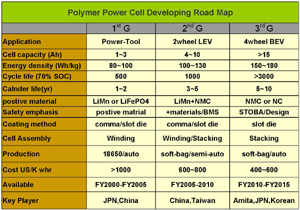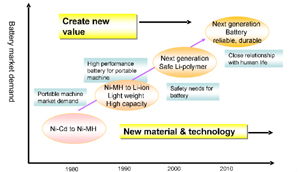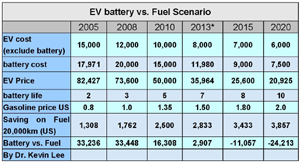Amita Focuses on Li-polymer Power Cells for Electric Vehicles
2010/08/23 | By Quincy LiangAmita Technologies Inc. is not satisfied with being among the top lithium polymer (Li-polymer) battery manufacturers in Taiwan. It wants to become a shining light in the vehicle-application lithium-ion power cell industry as well.
The company develops its own processes and methods for power-cell design pack design, manufacturing, and automation equipment. Working with key partners such as the Industrial Technology Research Institute (ITRI), Delta Electronics, and GP Electronics, it also develops and fine-tunes materials, electronics, automation, and battery logistics technologies.
In a recent interview with CENS, Dr. Kevin Lee, Amita’s new vice president for new business and technology, said that his company has already set clear goals for itself: development of larger-sized products, adoption of new and innovative technologies to upgrade battery safety, and the provision of turnkey products for customers around the world, notably vehicle makers.
Amita was established by Dr. Jim Cherng in 2000, who had accumulated more than 20 years of experience in the battery industry. The slogan he chose for his company was “Love Our Planet.” Other members of the firm’s management team are all highly educated professionals with abundant experience and expertise in the fields of telecommunications, chemical engineering, and batteries. After a decade of development, Amita now boasts a comprehensive R&D, production, and sales infrastructure.
Ready for the Leap
Amita’s main products are 8Ah-10Ah Li-polymer batteries up to A6 in size, and an A5 model will be introduced in the third quarter. Amita uses all major anode materials in its Li-polymer batteries, including LiMn204, LiFePO4, and nickel manganese cobalt (NMC), according to order. MiMn204 products currently account for 80% to 90% of total output.
A major boost for Amita’s progress came in 2008, when 30% of its shares were acquired by Delta Electronics, the world’s largest maker of power-supply units and an aggressive developer of battery electric vehicle (BEV) and hybrid electric vehicle (HEV) models. Delta hopes to make Amita into “a tiger with a pair of wings.”
Last year Amita turned its eyes more intensively on power cells for electric vehicles, focusing at first on light electric vehicles (LEVs). This generally refers to vehicles using less than 60V electric power, primarily electric bicycles and scooters. In 2009 the company shipped 20,000 battery packs (batteries together with battery management systems, or BMS), and this year it expects to move 60,000.
Core Pack
“Amita is not just a battery maker,” Lee stressed. “We are an integrated firm with in-house battery-packing capability. This means that we sell our batteries on the ‘module cell’ concept instead of providing cells alone. We call this the ‘core pack’ concept; we sell the core packs to our customers, who can develop and design their own pack housing for various kinds of applications.”
Amita has developed a standardized 26V, 10Ah Li-polymer cell module (with seven 3.7V polymer cells), mainly for electric-bicycle applications. Lee claims that this standardized pack module can give most electric-bicycle makers the power source they need, with the highest reliability and affordability. In addition to offering standard modules, the company also accepts orders for custom modules.
Lee reported that the company will introduce a standardized Li-polymer cell module for electric-scooter applications. This module is expected to meet the requirements for the NT$8,000 to NT$11,000 (US$246-338 at NT$32.5:US$1) subsidy that Taiwan’s government plans to offer for each e-scooter. The resulting sales will help Amita achieve an economic scale of production.
New Technology, New Hope
A new and innovative technology, STOBA (Self Terminated Oligomers with hyper-Branched Architecture), is expected to give Amita another strong boost into the power-cell business this year.
STOBA involves the integration of nano-grade high-molecular material into lithium batteries to form a protective film automatically and immediately whenever a battery is overheated, bashed, or pierced, stopping electro-chemical reactions that might be otherwise triggered and preventing short-circuiting that would generate excessive heat and present a fire hazard. STOBA-integrated lithium batteries are much safer for electronic devices and electric vehicles.

Lee claimed that Amita is one of very few companies in Taiwan that have been chosen to co-develop STOBA technology together with ITRI in a project sponsored by the Ministry of Economic Affairs.
“STOBA is an admirable solution for the upgrading of Li-ion battery safety, especially in high-power EV applications,” Lee comments, “and it gives Taiwan a rare chance to overtake Japan and South Korea in Li-ion battery technology.” Every Li-ion battery maker is struggling to overcome the safety issue, Lee went on to explain, some by increasing the thickness of separator film and some by improving electrolyte formulas; but internal short circuits remain a pivotal problem, because extended usage tends to result in chemical reactions or other changes that break through separator films and cause short circuits.

Turnkey Projects
Another Amita advantage is its ability to provide turnkey projects for Li-ion battery manufacturing and assembly. “With the full support of Delta Electronics,” Lee reported, “Amita now has full capability to provide turnkey projects for EV makers worldwide. We can supply standardized modules for local assembly by customers themselves, and we can teach our customers how to recycle the batteries and maintain the cells. We are even developing a system that will prolong the life of our batteries to seven to 10 years.”
Lee has no doubt that EV makers will have to cooperate closely with cell makers. “Automakers can never accept a situation in which batteries account for more than half of a vehicle’s total cost,” he explained. “That’s why most BEV models developed by the big automakers have only limited cruise range. The year 2013 will be a decisive year because then, we estimate, the average cost of a BEV, excluding batteries, will be about US$8,000 (compared with US$10,000 in 2010) and the batteries will cost around US$11,896 (US$15,000 in 2010), while cruise range will be extended to about 239 kilometers. More importantly, in 2013 the saving on fuel cost will be close to the cost of the batteries. We’ve actively working on new business models, such as battery leasing, and will continue our efforts to upgrade cell performance.”
Delta Electronics and Amita can jointly develop and produce all of the equipment needed for Li-polymer battery production, and install it in EV factories or other plants nearby.
“We invest a lot in Li-ion batteries,” Lee said, “because we want to prove at least three things: Li-ion batteries are safer than gasoline or diesel fuel, an electric motor on an EV is safer than an internal combustion engine, and Li-ion batteries have a much smaller impact on our environment than petroleum fuels. More than five million BEVs are expected to be sold in 2015, and the key factors affecting that forecast include battery price, fuel price, and sufficient infrastructure (notably battery charging and exchange stations.”
Li-polymer power cells have many advantages over other types of batteries, Lee claimed, including more balanced heat dissipation, higher energy density, and greater safety. This gives him confidence in Amita’s future, especially since the overseas plants of many auto makers that closed down or went bankrupt because of the global recession are hoping to survive by developing the EV market.
Amita currently has around 190 workers and an annual production capacity of approximately 25 million Ah (ampere-hour). Lee said that the capacity figure can easily be tripled, if necessary, by the installation of more automated production lines.





